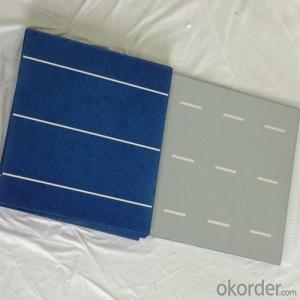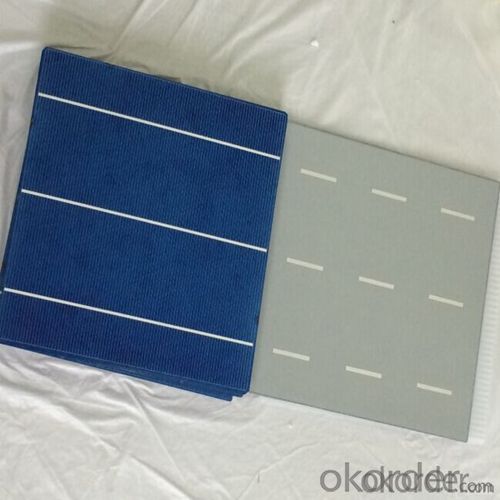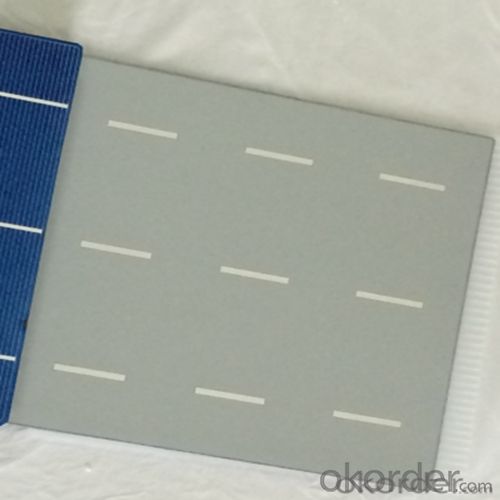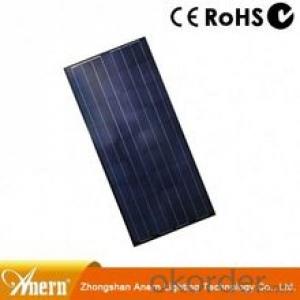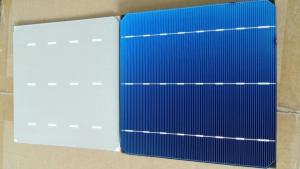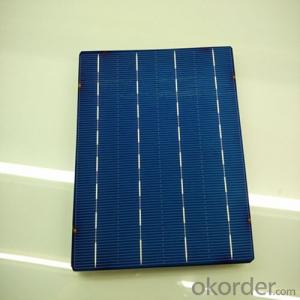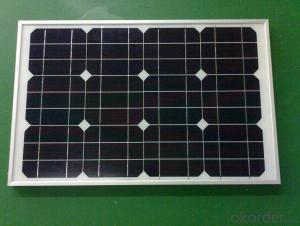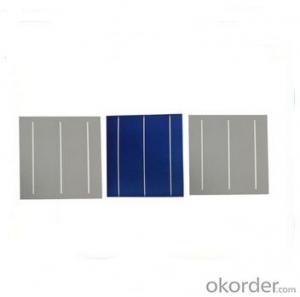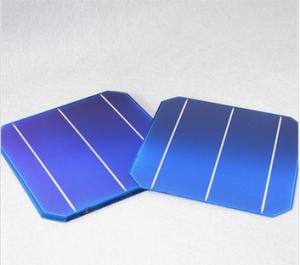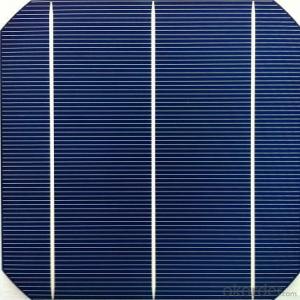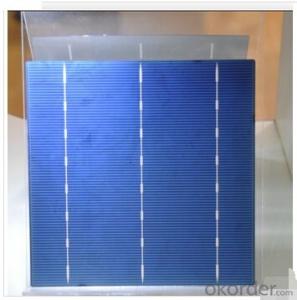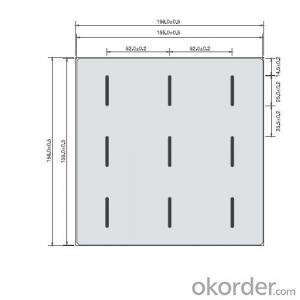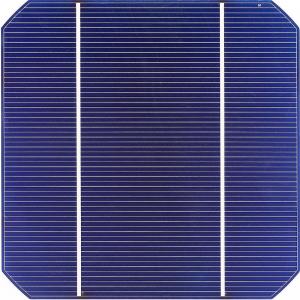Polymer Solar Cells 156*156mm B Grade Low Price
- Loading Port:
- Shanghai
- Payment Terms:
- TT or LC
- Min Order Qty:
- 30000 pc
- Supply Capability:
- 1000000 pc/month
OKorder Service Pledge
OKorder Financial Service
You Might Also Like
Product description
Poly Solar Cells 156*156mm B Grade Low Price
A solar cell, or photovoltaic cell, is an electrical device that converts the energy of light directly into electricity by the photovoltaic effect, which is a physical and chemical phenomenon.[1] It is a form of photoelectric cell, defined as a device whose electrical characteristics, such as current, voltage, or resistance, vary when exposed to light. Solar cells are the building blocks of photovoltaic modules, otherwise known as solar panels.
Solar cells are described as being photovoltaic irrespective of whether the source is sunlight or an artificial light. They are used as a photodetector (for example infrared detectors), detecting light or other electromagnetic radiation near the visible range, or measuring light intensity.
In contrast, a solar thermal collector supplies heat by absorbing sunlight, for the purpose of either direct heating or indirect electrical power generation from heat. A "photoelectrolytic cell" (photoelectrochemical cell), on the other hand, refers either to a type of photovoltaic cell (like that developed by Edmond Becquerel and modern dye-sensitized solar cells), or to a device that splits water directly into hydrogen and oxygen using only solar illumination.
Advantage Of Poly Solar Cell 156mm
1: High quality cell, Level A cell (14%—17.5%)
2.Dimensione:156*156mm Diagonal:200mm
3: Qualified certification: TUV,CE certification.
4: Warranty: five years for whole unit
Usage/Application Of Poly Solar Cell 156mm
1.The absorption of light, generating either electron-hole pairs or excitons.
2.The separation of charge carriers of opposite types.
3.The separate extraction of those carriers to an external circuit.
Packaging & Delivery Of Poly Solar Cell 156mm | |
Packaging Detai | Packaging Detail:Export Carton and Pallet or under customer request. |
delivery Detail:10-20days | |
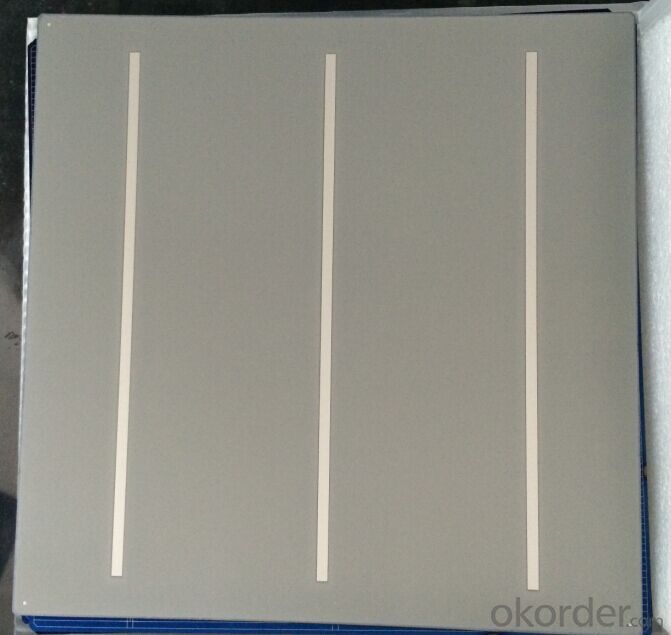
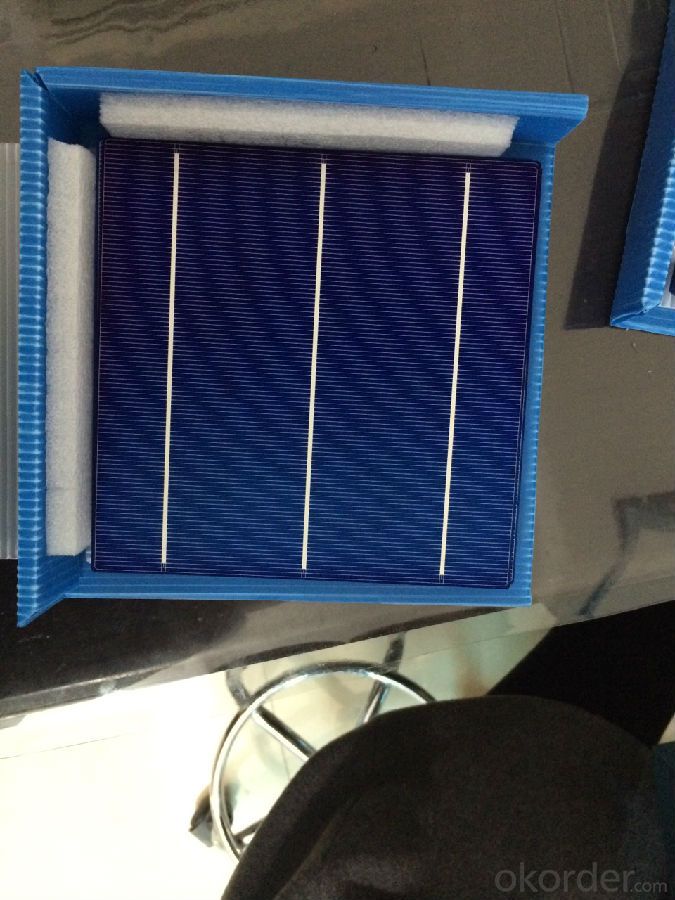
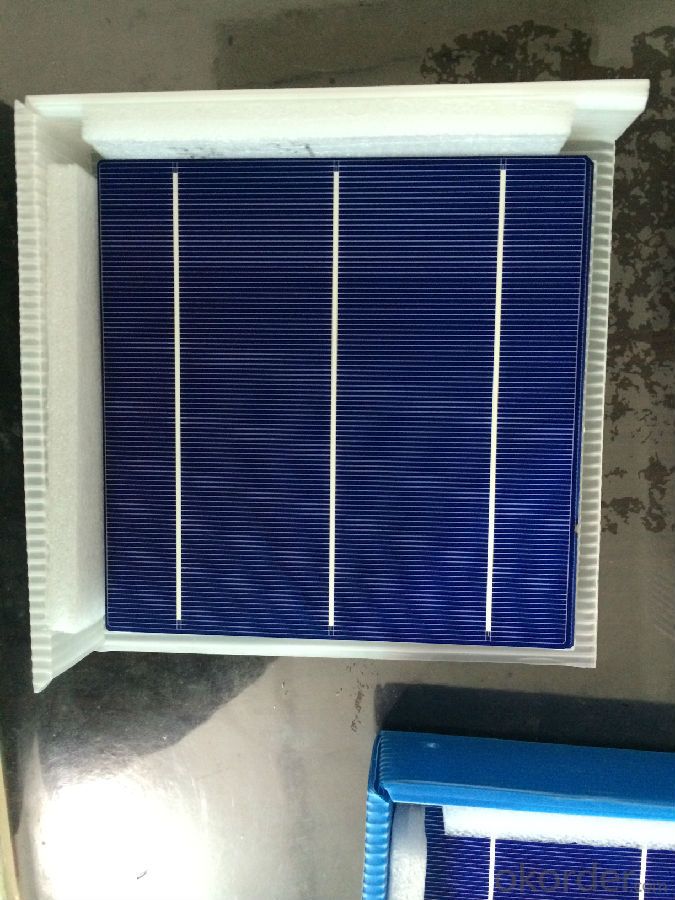
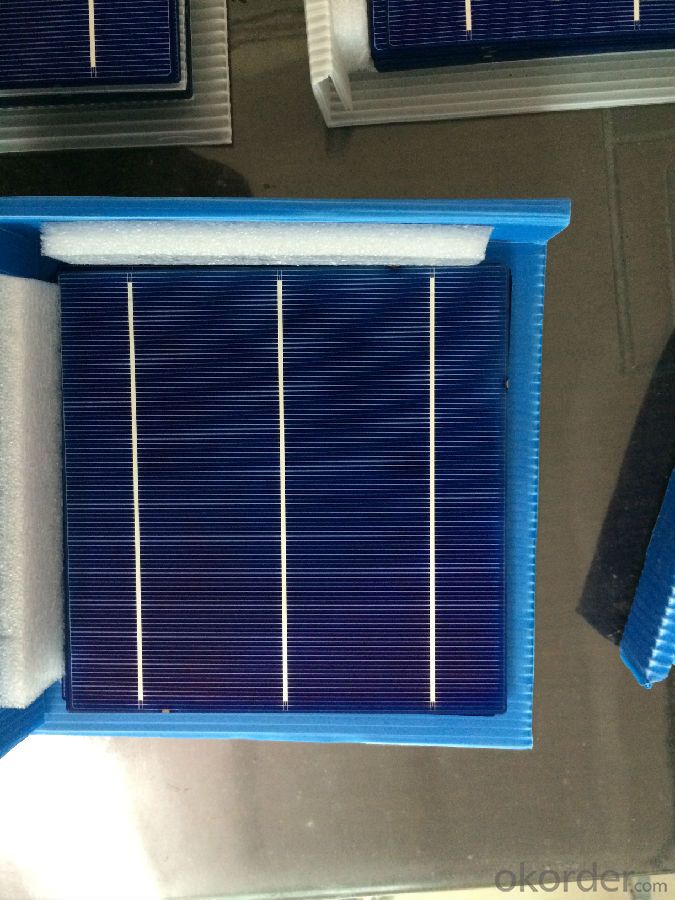
Product Specifician
Electrical Characteristic
Efficiency (%) | Pmpp (W) | Umpp (V) | Impp (A) | Uoc (V) | Isc (A) | FF (%) |
17.25 | 4.197 | 0.524 | 7.992 | 0.62 | 8.458 | 80.03% |
17 | 4.137 | 0.524 | 7.876 | 0.619 | 8.353 | 80.01% |
16.75 | 4.076 | 0.522 | 7.81 | 0.617 | 8.286 | 79.73% |
16.5 | 4.015 | 0.518 | 7.746 | 0.613 | 8.215 | 79.73 |
16.25 | 3.955 | 0.515 | 7.683 | 0.61 | 8.144 | 79.61% |
16 | 3.894 | 0.512 | 7.613 | 0.608 | 8.075 | 79.31% |
15.75 | 3.833 | 0.51 | 7.534 | 0.605 | 8.058 | 78.62% |
15.5 | 3.772 | 0.508 | 7.453 | 0.604 | 8.02 | 77.87% |
15.25 | 3.771 | 0.505 | 7.35 | 0.604 | 9.997 | 76.83% |
15 | 3.65 | 0.503 | 7.271 | 0.604 | 7.989 | 75.64% |
14.5 | 3.529 | 0.499 | 7.067 | 0.604 | 7.988 | 73.14% |
14 | 3.407 | 0.499 | 6.833 | 0.604 | 7.833 | 72.01% |
Intensity Dependence
Intensity [W/m2] | Isc× [mA] | Voc× [mV] |
1000 | 1.00 | 1.000 |
900 | 0.90 | 0.989 |
500 | 0.50 | 0.963 |
300 | 0.30 | 0.939 |
200 | 0.20 | 0.920 |
FAQ
Q:What price for each watt?
A:It depends on the quantity, delivery date and payment terms
Q:What is your warranty system?
A:Our Solar cells performance guarantees for 25 years
Q:How do you pack your products?
A:We have rich experience on how to pack thecells to make sure the safety on shipment when it arrives at the destination.
What is the solar cell
A photoelectric cell designed to convert sunlight into electrical energy,typically consisting of layers or sheets of specially prepared silicon.Electrons, displaced through the photoelectric by the Sun's radiantenergy in one layer, flow across a junction to the other layer, creating avoltage across the layers that can provide power to an external circuit.Solar cells are used as power supplies in calculators, satellites, and otherdevices, and as a primary source of electricity in remote locations.
What is a Solar Cell
A solar cell or photovoltaic cell is a device which generates electricity directly from visible light by means of the photovoltaic effect. In order to generate useful power, it is necessary to connect a number of cells together to form a solar panel, also known as a photovoltaic module. There is more about the the different types of solar cell . The nominal output voltage of a solar panel is usually 12 Volts, and they may be used singly or wired together into an array. The number and size required is determined by the available light and the amount of energy required.
73. What is the tiny little but the most efficient solar cell
While solar power promises a lot and always free compared to other energy, it's only ever going to help satisfy our energy needs if it becomes efficient enough. Fortunately, some solar cell companies has just made the world's most efficient solar cell, which converts a staggering 44.4 percent of incident light into electricity. Fossil fuels may spend less space of our energy.
The cell uses a special lens-based concentrator system, which focuses sunlight onto the cell to help improve the efficiency. Once, the light's focussed, a stack of three photo-absorption layers convert it into electricity. Even then it's no mean feat to squeeze out an efficiency of 44.4 percent, and the process saw Sharp invest a huge amount of time in tuning the device's dimensions to focus the light properly and reduce losses between layers.
While it's impressive, you probably won't see one strapped to the roof of a house any time soon. Devices this exotic are more likely to end up on a spacecraft in the first instance, where efficiency trumps cost every time. That's not to say it won't ever make it to the domestic market—it might just take a little time.
The system of solar cell
The amount of power generated by solar cells is determined by the amount of light falling on them, which is in turn determined by the weather and time of day. In the majority of cases some form of energy storage will be necessary.
In a Grid-connected system, the solar array is connected to the mains. Any surplus power is sold to the electricity company, and power is bought back from them when it is needed.
In a Stand-alone system, however, this is not possible. In this type of system the usual choice for energy storage is the lead-acid battery. The number and type of batteries is dependent on the amount of energy storage needed. Find out more about batteries
- Q: How can I explain to my 10 year old daughter what solar cells are?
- According to Wikipedia: A solar cell, or photovoltaic cell (in very early days also termed "solar battery"[1] – a denotation which nowadays has a totally different meaning, see here), is an electrical device that converts the energy of light directly into electricity by the photovoltaic effect, which is a physical and chemical phenomenon.
- Q: Can solar cells be used in hybrid systems?
- Yes, solar cells can indeed be used in hybrid systems. Hybrid systems combine multiple sources of energy, such as solar, wind, or traditional grid power, to ensure a more reliable and efficient energy supply. Solar cells can be integrated into these hybrid systems to generate electricity from sunlight, which can be used alongside other sources to meet the energy demands of a particular system or application.
- Q: How do solar cells perform in dusty environments?
- Solar cells can experience a decrease in performance in dusty environments as dust particles can block sunlight from reaching the surface of the cells, reducing their efficiency. Regular cleaning and maintenance are necessary to ensure optimal performance in such conditions.
- Q: What is the impact of solar cells on reducing dependence on foreign energy sources?
- Solar cells have a significant impact on reducing dependence on foreign energy sources by providing a renewable and locally available source of electricity. By harnessing the power of the sun, solar cells offer a clean and sustainable alternative to fossil fuels, which often need to be imported from other countries. This shift towards solar energy not only enhances energy security but also reduces reliance on foreign nations for energy supply, thus promoting self-sufficiency and reducing geopolitical risks associated with energy imports.
- Q: What is the effect of wind on solar cell performance?
- The effect of wind on solar cell performance can be both positive and negative. On one hand, wind can help cool the solar cells, preventing overheating and improving their overall efficiency. Additionally, wind can help clean the surface of the solar panels, removing dust and debris that may obstruct sunlight and reduce energy production. On the other hand, strong winds can create vibrations and mechanical stress on the solar panels, potentially damaging their structure or causing misalignment. Therefore, while some wind is beneficial for solar cell performance, excessive or turbulent wind conditions may have a detrimental impact.
- Q: Is it complicated to make a solar cell work well?
- For the professionals, it is not complicated at all.
- Q: Can solar cells be used on vehicles other than cars?
- Yes, solar cells can be used on vehicles other than cars. Solar cells can be integrated into various types of vehicles including buses, motorcycles, bicycles, boats, and even spacecraft. The energy generated by solar cells can be used to power the vehicle's electrical systems, reduce reliance on fossil fuels, and contribute to a more sustainable transportation infrastructure.
- Q: Can solar cells be used in desalination plants?
- Yes, solar cells can be used in desalination plants. Solar energy can be harnessed to power the desalination process, either directly or indirectly. Direct methods involve using solar panels to generate electricity to power the desalination process, while indirect methods involve using solar thermal energy to heat the water and drive the desalination process. Both methods have been successfully implemented in various desalination plants around the world, offering a sustainable and environmentally-friendly solution to produce fresh water.
- Q: Can solar cells be installed on vehicles?
- Yes, solar cells can be installed on vehicles. In fact, solar panels are increasingly being used to power various components of vehicles, such as electric cars, hybrid cars, and even boats. These solar cells harness sunlight and convert it into electricity to charge the vehicle's batteries, reducing the reliance on traditional fuel sources and making them more environmentally friendly.
- Q: How is the efficiency of a solar cell calculated?
- The efficiency of a solar cell is calculated by dividing the maximum power output of the cell by the input power from the sunlight.
Send your message to us
Polymer Solar Cells 156*156mm B Grade Low Price
- Loading Port:
- Shanghai
- Payment Terms:
- TT or LC
- Min Order Qty:
- 30000 pc
- Supply Capability:
- 1000000 pc/month
OKorder Service Pledge
OKorder Financial Service
Similar products
Hot products
Hot Searches
Related keywords
